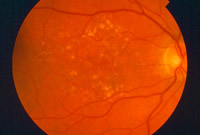 The macula is a part of the retina in the back of the eye that ensures that our central vision is clear and sharp. Age-related macular degeneration (AMD) occurs when the arteries that nourish the retina harden. Deprived of nutrients, the retinal tissues begin to weaken and die, causing vision loss. Patients may experience anything from a blurry, gray or distorted area to a blind spot in the center of vision.
The macula is a part of the retina in the back of the eye that ensures that our central vision is clear and sharp. Age-related macular degeneration (AMD) occurs when the arteries that nourish the retina harden. Deprived of nutrients, the retinal tissues begin to weaken and die, causing vision loss. Patients may experience anything from a blurry, gray or distorted area to a blind spot in the center of vision.
AMD is the number-one cause of vision loss in the U.S. Macular degeneration doesn't cause total blindness because it doesn't affect the peripheral vision. Possible risk factors include genetics, age, diet, smoking and sunlight exposure. Regular eye exams are highly recommended to detect macular degeneration early and prevent permanent vision loss.
A cataract is a cloudy area in the lens in the front of the eye. There is no pain associated with the condition but there are other symptoms, including:
Most people develop cataracts simply as a result of aging, with the majority of cases occurring in people over the age of 55. Over 1.2 million Americans are diagnosed with cataracts each year. Other risk factors include eye injury or disease, a family history of cataracts, smoking or use of certain medications.
For people who are significantly affected by cataracts, lens replacement surgery may be recommended.
 Diabetic retinopathy is a complication of diabetes that weakens the blood vessels that supply nourishment to the retina (the light-sensitive lining in the back of the eye where vision is focused). These weak vessels can leak, swell or develop thin branches, causing a loss of vision. Changes to your vision may not be noticeable at first. But in its advanced stages, the disease can cause blurred or cloudy vision, floaters and blind spots – and, eventually, blindness. This damage is irreversible. Diabetic retinopathy is the most common diabetic eye complication and a leading cause of blindness in American adults. Macular edema, which is leaking fluid that causes blurred vision, often occurs with diabetic retinopathy.
Diabetic retinopathy is a complication of diabetes that weakens the blood vessels that supply nourishment to the retina (the light-sensitive lining in the back of the eye where vision is focused). These weak vessels can leak, swell or develop thin branches, causing a loss of vision. Changes to your vision may not be noticeable at first. But in its advanced stages, the disease can cause blurred or cloudy vision, floaters and blind spots – and, eventually, blindness. This damage is irreversible. Diabetic retinopathy is the most common diabetic eye complication and a leading cause of blindness in American adults. Macular edema, which is leaking fluid that causes blurred vision, often occurs with diabetic retinopathy.
Regular eye exams are an integral part of making sure your eyes are healthy. Diabetic retinopathy can be detected through a visual acuity test, a dilated eye exam or tonometry.
Although damage caused by diabetic retinopathy cannot be corrected, patients diagnosed with the condition can be treated to slow its progression and prevent further vision loss. Treatment modalities include laser and surgical procedures.
The vitreous is a clear liquid that fills our eyes and gives them shape. When we are young, the vitreous has a thick, gelatinous consistency and is firmly attached to the retina. As we age, the vitreous thins and separates from the retina. Although this usually results in nothing more than a few harmless floaters, tension from the detached vitreous can sometimes tear the retina.
If liquid seeps through the tear and collects behind the retina or between its nerve layers, the retinal tear can become a retinal detachment. Retinal detachment can cause significant, permanent vision loss and requires immediate medical treatment.
Signs of retinal tear or detachment include flashes of light, a group or web of floaters, wavy or watery vision, a sense that there is a veil or curtain obstructing peripheral vision, or a sudden drop in vision quality. If you experience any of these symptoms, call your doctor immediately. Early treatment is essential to preserve your vision and is usually done through laser and cryoprobe procedures.
Flashes in vision occur as a result of pressure on the retina in the back of the eye, and causes patients to see flashing lights or lightning streaks. Floaters occur when fibers move across the vitreous and into your field of vision, causing patients to see specks, strands, webs or other shapes as the fibers cast shadows on the retina. These spots are most visible when looking at a plain, light background.
Although flashes and floaters are common, especially as we age, it is important to see your doctor if you experience them.
Allergic eye disease, or allergic conjunctivitis, makes the eyes feel itchy, red, watery and light-sensitive and can cause swelling of the eyelids. The allergy may be seasonal, often occurring alongside hay fever, or it may occur throughout the year, known as perennial, as a result of exposure to allergens such as dust mites, mold or animal dander. Both are very common conditions, especially for patients with family histories of asthma, eczema or rhinitis. Less frequently, people can develop allergic eye disease from wearing hard or soft contact lenses, as a complication of atopic eczema, or for other reasons. Patients with this condition may also suffer from dry eyes and blepharitis.
Page 1 | Page 2